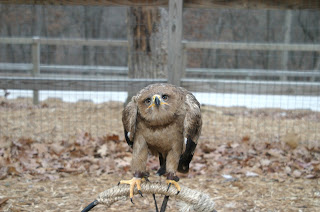When I first arrived at the World Bird Sanctuary I was prepared to work with birds of prey, and even the parrots that I had viewed during my tour.
After all, who doesn’t want a chance to interact with intelligent and mimicking birds? What I did not count on was meeting the crows and ravens who take bird intelligence to a whole new level.
Lenore, a White Necked Raven--when no toys are available a twig will do
One of the upsides to working with Corvids?--their intelligence. Crows, ravens, jays and magpies are all members of the family Corvidae and are some of the most intelligent birds in the world. They are able to learn numbers, colors, shapes and sizes, as well as mimic sounds. This includes everything from human voices to the calls of other wild birds. Blue jays have been heard screaming like red-tailed hawks at crowded bird feeders. These creative Corvids then enjoy all of the tasty seed left by the other songbirds, which vacated when they heard “the Red-tail.”
This characteristic intelligence makes them a great joy to work with and train. They are able to understand a variety of different behaviors including stacking rings, puzzle balls, recycling, toy pick up and painting. We also use them to collect donations after programs by harnessing their natural behavior of caching. Corvids will set aside and hide food to eat later. By giving our birds a food reward we can encourage them to stash money instead--turning caching into cashing.
Mischief, a White Necked Raven, demonstrates caching behavior
One of the downsides to working with Corvids?--their intelligence. Being such clever birds also makes them excellent problem solvers and sometimes they problem solve against us.
Our crows and ravens are not so thrilled when we go to collect their leftovers, including anything they may have cached, so they will occasionally fake us out. Instead of standing protectively by their real cache, they will guard an empty pile of shavings in a corner of their enclosure. By the time they have moved and we discover the deception they are sitting on their perch enjoying some leftover tidbits from the still undiscovered cache.
During show season they become escape artists, undoing show clips and untying knots. They also have excellent memories so if they happen to find food that someone has dropped they will head back to that same location, show after show, in search of more.
Corvid toys look suspiciously like what you might use to entertain your 2-year-old (except for the soda can)
This creativity means we need to keep our birds entertained with a variety of activities and toys. If we don’t, they invent their own ways to keep entertained. Lenore, one of our White-necked Ravens is a big fan of “help I’m stuck”. She will sit on her perch in the Nature Center weathering area, wait for a large group of people and then hop to the ground. She will then hop pathetically towards her perch, giving the appearance that her jesses are caught and she is stuck. Once a staff member has been alerted by a concerned guest, Lenore will hop up to her perch without any problem. This is one of her favorite games, and since our birds’ safety is such a priority we always check on her.
Little Guy carrying one of her rings
Little Guy, another White-necked Raven, enjoys seeing how often she can be rewarded during a behavior. When stacking rings, she will look up at unsuspecting humans between rings hoping to prod them into giving her a treat for every individual ring rather than stacking the whole tower.
Cherry an African Pied Crow is excellent at tricking people into doing most of the behavior for her. She sits and stares and will on occasion nudge the items, causing many people to think she needs help…clever crow.
Cherry, an African Pied Crow, trying to train the trainer
Corvids have a bad rap, often being connected through myth and legend with death and murder. What many people do not realize is that they are incredibly intelligent and social creatures. Working with them is a true delight although it does often pose the question: who exactly is being trained?
Mischief, a White Necked Raven, accepting donations from an audience member
If you would like to interact with one of these incredibly intelligent creatures, join us for World Eagle Day on March 20 when one of these remarkable birds will do it’s donation collection routine.
Submitted by Leah Tyndall, World Bird Sanctuary Naturalist/Trainer













































